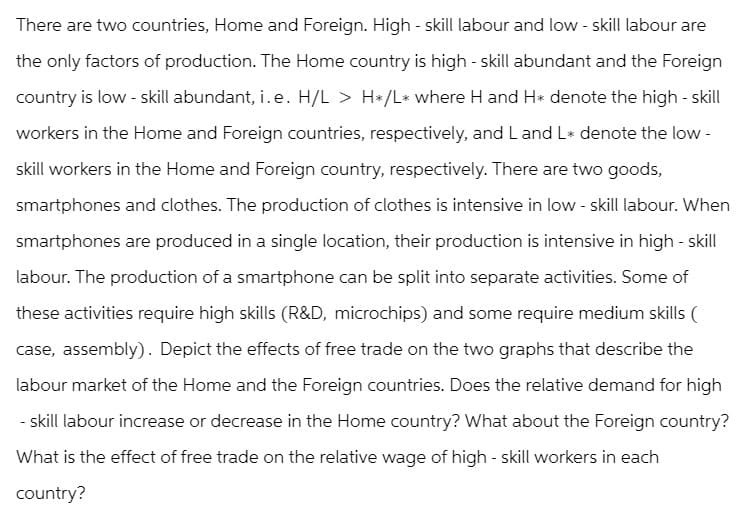There are two countries, Home and Foreign. High - skill labour and low - skill labour are the only factors of production. The Home country is high - skill abundant and the Foreign country is low-skill abundant, i. e. H/L > H*/L* where H and H* denote the high - skill workers in the Home and Foreign countries, respectively, and L and L* denote the low- skill workers in the Home and Foreign country, respectively. There are two goods, smartphones and clothes. The production of clothes is intensive in low - skill labour. When smartphones are produced in a single location, their production is intensive in high-skill labour. The production of a smartphone can be split into separate activities. Some of these activities require high skills (R&D, microchips) and some require medium skills ( case, assembly). Depict the effects of free trade on the two graphs that describe the labour market of the Home and the Foreign countries. Does the relative demand for high - skill labour increase or decrease in the Home country? What about the Foreign country? What is the effect of free trade on the relative wage of high skill workers in each country?
There are two countries, Home and Foreign. High - skill labour and low - skill labour are the only factors of production. The Home country is high - skill abundant and the Foreign country is low-skill abundant, i. e. H/L > H*/L* where H and H* denote the high - skill workers in the Home and Foreign countries, respectively, and L and L* denote the low- skill workers in the Home and Foreign country, respectively. There are two goods, smartphones and clothes. The production of clothes is intensive in low - skill labour. When smartphones are produced in a single location, their production is intensive in high-skill labour. The production of a smartphone can be split into separate activities. Some of these activities require high skills (R&D, microchips) and some require medium skills ( case, assembly). Depict the effects of free trade on the two graphs that describe the labour market of the Home and the Foreign countries. Does the relative demand for high - skill labour increase or decrease in the Home country? What about the Foreign country? What is the effect of free trade on the relative wage of high skill workers in each country?
Chapter1: Making Economics Decisions
Section: Chapter Questions
Problem 1QTC
Related questions
Question

Transcribed Image Text:There are two countries, Home and Foreign. High - skill labour and low-skill labour are
the only factors of production. The Home country is high - skill abundant and the Foreign
country is low-skill abundant, i. e. H/L > H*/L* where H and H* denote the high-skill
workers in the Home and Foreign countries, respectively, and L and L* denote the low-
skill workers in the Home and Foreign country, respectively. There are two goods,
smartphones and clothes. The production of clothes is intensive in low-skill labour. When
smartphones are produced in a single location, their production is intensive in high-skill
labour. The production of a smartphone can be split into separate activities. Some of
these activities require high skills (R&D, microchips) and some require medium skills (
case, assembly). Depict the effects of free trade on the two graphs that describe the
labour market of the Home and the Foreign countries. Does the relative demand for high
-skill labour increase or decrease in the Home country? What about the Foreign country?
What is the effect of free trade on the relative wage of high - skill workers in each
country?
Expert Solution
This question has been solved!
Explore an expertly crafted, step-by-step solution for a thorough understanding of key concepts.
Step by step
Solved in 3 steps with 4 images

Knowledge Booster
Learn more about
Need a deep-dive on the concept behind this application? Look no further. Learn more about this topic, economics and related others by exploring similar questions and additional content below.Recommended textbooks for you


Principles of Economics (12th Edition)
Economics
ISBN:
9780134078779
Author:
Karl E. Case, Ray C. Fair, Sharon E. Oster
Publisher:
PEARSON

Engineering Economy (17th Edition)
Economics
ISBN:
9780134870069
Author:
William G. Sullivan, Elin M. Wicks, C. Patrick Koelling
Publisher:
PEARSON


Principles of Economics (12th Edition)
Economics
ISBN:
9780134078779
Author:
Karl E. Case, Ray C. Fair, Sharon E. Oster
Publisher:
PEARSON

Engineering Economy (17th Edition)
Economics
ISBN:
9780134870069
Author:
William G. Sullivan, Elin M. Wicks, C. Patrick Koelling
Publisher:
PEARSON

Principles of Economics (MindTap Course List)
Economics
ISBN:
9781305585126
Author:
N. Gregory Mankiw
Publisher:
Cengage Learning

Managerial Economics: A Problem Solving Approach
Economics
ISBN:
9781337106665
Author:
Luke M. Froeb, Brian T. McCann, Michael R. Ward, Mike Shor
Publisher:
Cengage Learning

Managerial Economics & Business Strategy (Mcgraw-…
Economics
ISBN:
9781259290619
Author:
Michael Baye, Jeff Prince
Publisher:
McGraw-Hill Education